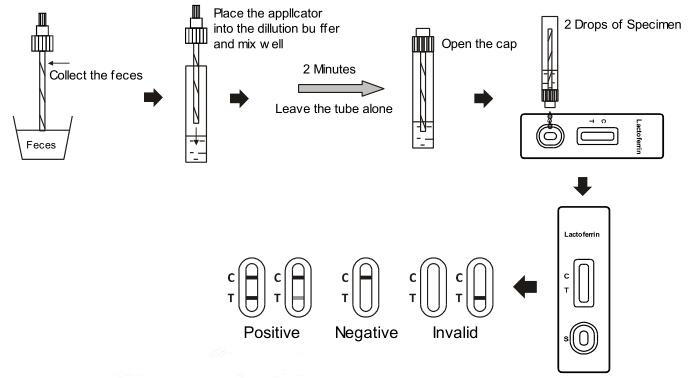【SUMMARY】
Inflammatory bowel disease (IBD) involves a large clinical spectrum of disease presentations from mild to severe symptoms in relation to different disease locations and the extent from possible rectal to upper intestinal
involvement. In pediatric patients, early diagnosis of IBD is of great relevance and essential for best outcome. Induction of remission by specific therapy aims to improve the patient’s symptoms, to maintain or restore the quality of life as soon as possible, and to prevent complications of the disease. Human lactoferrin, a neutrophil derived glycoprotein, can be measured in feces and whole gut lavage as an indicator of intestinal inflammation in both IBD and infectious gastroenteritis. Recent studies have shown fecal lactoferrin (FL) as a sensitive biomarker for pediatric IBD. In addition, this biomarker can serve as an aid for guiding the diagnostic and therapeutic process for both pediatric and adult IBD.
【DIRECTIONS FOR USE】
Allow the test, specimen, buffer and/or controls to reach room temperature (15- 30°C) prior to testing.
1. Collection of fecal specimens:
Collect sufficient quantity of feces (1-2 mL or 1-2 g) in a clean, dry specimen collection container to obtain maximum antigens (if present). Best results will be obtained if the assay is performed within 6 hours after collection. Specimen collected may be stored for 3 days at 2-8℃ if not tested within 6 hours. For long term storage, specimens should be kept below -20℃.
2. Processing of fecal specimens:
• For Solid Specimens:
Unscrew the cap of the specimen collection tube,then randomly stab the specimen collection applicator into the fecal specimen in at least 3 different sites to collect approximately 50 mg of feces (equivalent to 1/4 of a pea). Do not scoop the fecal specimen.
• For Liquid Specimens:
Hold the dropper vertically, aspirate fecal specimens, and then transfer 2 drops (approximately 80μL) into the specimen collection tube containing the extraction buffer.
3. Tighten the cap onto the specimen collection tube, then shake the specimen collection tube vigorously to mix the specimen and the extraction buffer. Leave the tube alone for 2 minutes.
4. Bring the pouch to room temperature before opening it. Remove the test cassette from the foil pouch and use it within one hour. Best results will be obtained if the test is performed immediately after opening the foil pouch.
5. Hold the specimen collection tube upright and open the cap onto the specimen collection tube. Invert the specimen collection tube and transfer 2 full drops of the extracted specimen (approximately 80μL) to the specimen well (S) of the test cassette, then start the timer. Avoid trapping air bubbles in the specimen well (S). See illustration below.
6. Read results at 5 minutes after dispensing the specimen. Do not read results after 10 minutes.
7. Note: If the specimen does not migrate (presence of particles), centrifuge the extracted specimens contained in the extraction buffer vial. Collect 80μL of supernatant, dispense into the specimen well (S) of a new test cassette and start afresh following the instructions mentioned above.

|
Cat. No. |
Product Description |
Specimen |
Format |
Kit Size |
Cut-Off |
Status |
|
OLF-602 |
Lactoferrin Rapid Test Cassette |
Feces |
Cassette |
10 T |
100ng/mL |
CE |
 Malaysia
Malaysia